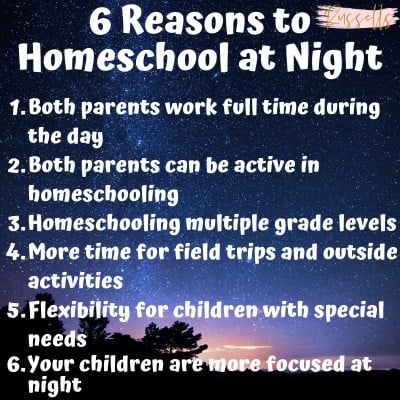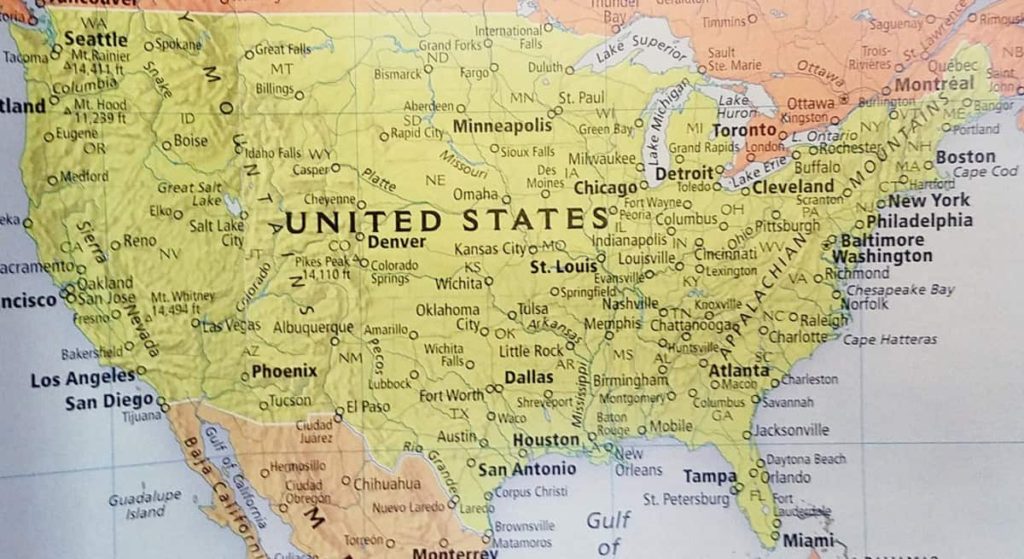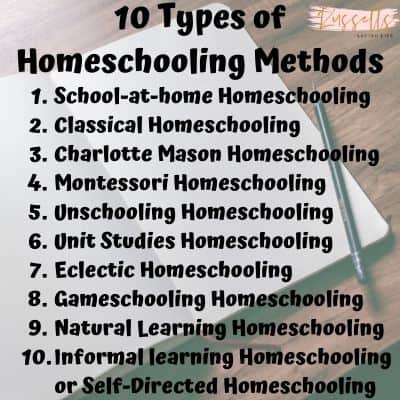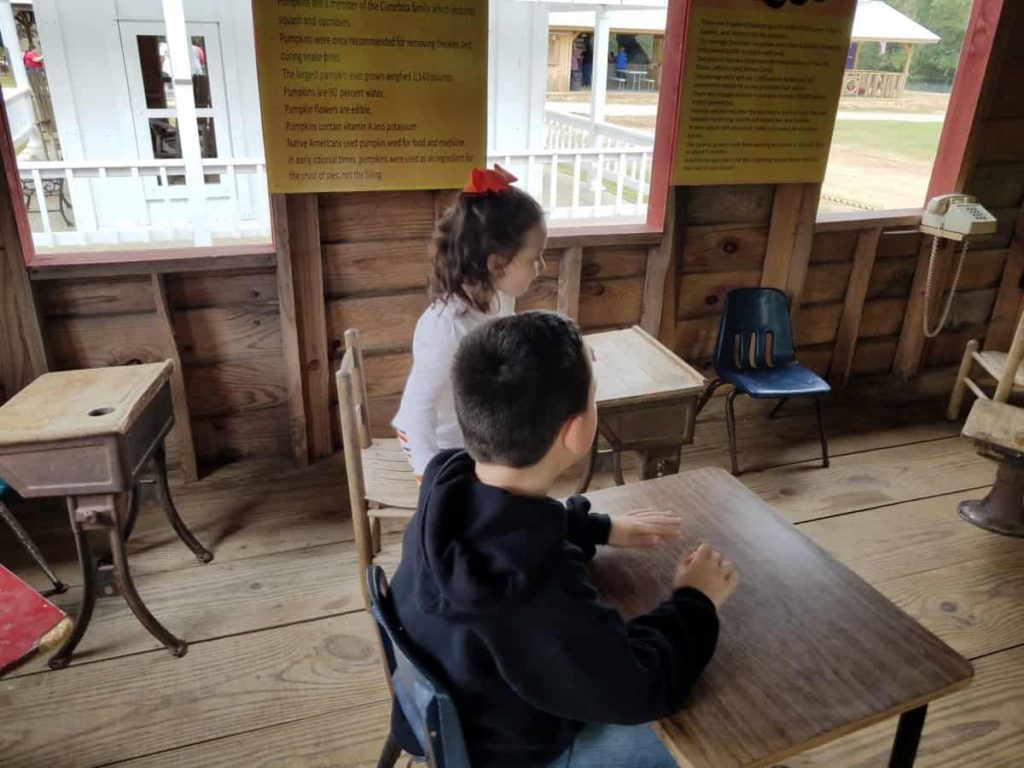I had never really thought about homeschooling at night until I was doing some research for another post and came across the topic homeschooling at night or homeschool night school.
Homeschooling at night or homeschool night school is when the children are taught at night. Some families decide to do this because the parents work a full time job and still want to homeschool their children, others do homeschool night school because it allows them to do more hands on learning during the daytime hours, and finally some families homeschool at night because it works better for their family schedule.
When homeschooling there is no right or wrong time of day. You do what works best for your family and follows your state’s homeschool laws. If you are not sure, what your homeschool laws are for you state, here is a link to the HSLDA.
We do not have a set schedule to homeschool. And what I mean by set schedule is we do not start school every day at a specific time. We have more of a homeschool routine. We do our homeschooling in the morning because that is what works best for us. Our routine is we wake up, eat breakfast, then we start school. I start Bailey on work he can do independently while I work with Bekah. When I’m done with my one on one work with Bekah, then I move to my one on one time with Bailey. Then we usually take a break for lunch and then we finish up school work for the day.
Can homeschooling be done at night?
Yes, homeschooling can be done at night. When you homeschool you can do what works best for your family as long as you follow your state’s homeschool laws.
6 Reasons to Homeschool at Night

- Both parents work full time during the day – Homeschooling at night works best for families were both parents work a full time job during the day and still want to homeschool.
- Both parents can be active in homeschooling – Homeschooling at night works best for families who want or need both parents to be active in teaching homeschool lessons.
- Homeschooling multiple grade levels – Teaching multiple grades at the same time can be a challenge for one person. So some families decided to homeschool during the day and night. They find that this works best for them.
- More time for field trips and outside activities – Some homeschool families decided to night homeschooling so they can enjoy more outside hands on learning during the daytime hours. Others like to enjoy daytime field trips when places are not as busy. This allows them time to enjoy, learn and not be rushed through the field trip.
- Flexibility for children with special needs – Most children with special needs have doctor’s appointment, physical theory, speech theory, or other required appointments during the day. So night school may work better for them and their siblings.
- Your children are more focused at night – Homeschooling at night may work better for children that focus better at night. Some children have tons of energy that they need to burn off during the day. Some families may have little ones that keep the older one detracted during the day, so when the littles are in bed it is easier for them to focus on school.
How many hours a day should you homeschool?
There is not a definite answer to this question. There are many factors that play into this. Some of these factors are the child’s age, child’s learning abilities, child’s learning style, curriculum, and how many children you are teaching at one time.
Bailey is now in the 5th grade and he has been homeschooled his entire life, so here is what I have learned over the years. We use My Father’s World Homeschool Curriculums and Saxon Math and on average here is how long we homeschooled a day per grade:
- Kindergarten took 45 mins to 1.5 hours
- First Grade took 2 hours to 3 hours
- Second Grade took 2 hours to 3.5 hours
- Third Grade took 2.5 hours to 3.5 hours
- Fourth Grade took 3 hours to 4 hours
- Fifth Grade takes 3 to 4.5 hours
This is just an average. Some day are shorter than others. It just depends on how quickly he picks up what he is being taught that day. These times to not include breaks or lunch time.

How many days a week do you homeschool?
This answer is different for every homeschool family. We homeschool four days a week so we can have one day a week for field trips, doctor appointment or just some fun outside activities. We also homeschool from late September to the end of July.
Can you homeschool and still have a full time job?
Yes you can! Flexibility is a great part of homeschooling. Homeschooling can be done during the day or at night. More and more working families are learning that they can homeschool and work a full time job inside or outside of the home.
Can you homeschool on weekends?
The best part of homeschooling is you can create a schedule that works best for your family. Some states require you to school for 180 days per school year and some do not so make sure you are following your state’s homeschool laws.
What does it mean to be homeschooled?
Homeschooled is when the primary educations takes place at home and not in a public or private school. Someone asked Bailey this question a few years ago and here was his answer, “It is when one parent stays home with you and teaches you and the other parents works a bunch.” Kids say the funniest things.

Can I legally homeschool in my state?
According to HSLDA it is legal to homeschool in all 50 states, but every state controls their own laws. So make sure to check your state’s laws and requirements.
Alabama, Alaska, Arizona, Arkansas, California, Connecticut, Delaware, Georgia, Idaho, Illinois, Indiana, Iowa, Kansas, Kentucky, Michigan, Mississippi, Missouri, Montana, Nebraska, Nevada, New Jersey, New Mexico, Oklahoma, Texas, Utah, Wisconsin, and Wyoming are considered Homeschool Friendly States. That means that their laws and regulations are more laid back and do not have as many laws or requirements.
Colorado, Florida, Hawaii, Louisiana, Main, Maryland, Massachusetts, Minnesota, New Hampshire, New York, North Carolina, North Dakota, Ohio, Oregon, Pennsylvania, Rhode Island, South Carolina, South Dakota, Tennessee, Vermont, Virginia, Washington, and West Virginia are considered not to be Homeschool Friendly States. This means that they have moderate to high regulations. They are more strict and have more requirements.
Which states require parent qualifications?
According to the Coalition for Responsible Home Education or CRHE your are required to have a High School Diploma or a GED in Georgia, New Mexico, North Carolina, North Dakota, Ohio, Pennsylvania, South Carolina, Tennessee, Virginia, Washington, and West Virginia.
What do I need to know if I decide to homeschool or homeschool night school?
First you want to find out your homeschool laws for your state. The best place to do that is Home School Legal Defense Association, HSLDA. The second thing you need to do is find out which of the 10 types of homeschooling you want to do or what fits your family better. Next, you need to learn how your child learns. There is a list of 7 ways children learn listed below. Then you need to join or find a homeschool group in your area. Yes they are great for the kids to interact with others kids, but it is also a great resource for all homeschooling moms and dads. Finally, if your child or children have attended a public or private school know there is an adjustment period for you both. This adjustment period is called deschooling. Click here to learn more about deschooling or read the short description below.
10 Types of Homeschooling Methods

- School-at-Home Homeschooling – School-at-home is when you mimic public or private schools in your home. Most new homeschooling families start with this method until they figure out what works best for them. Most of the time, when you buy an All-In-One curriculum or School in a box this is the type of method you are doing. We have used this method since we stared homeschooling and it is what works best for us, but it may not work well for everyone. We use My Father’s World curriculum and we love it!
- Classical Homeschooling – Classical homeschooling focuses on a three part process. The first part is the Grammar Stage. The Grammar Stage is when you build a basic knowledge of the core subjects like math, language arts, science and history. The second part is the Logic Stage. The Logic State is when children want to know more about a topic or subject. Children typically state asking “why”. These questions help them to reach a conclusion on their own. The Third and final part is the Abstract Stage. The Abstract or Rhetoric Stage combines their knowledge of core subjects and their ability to reach a conclusion together.
- Charlotte Mason Homeschooling – Charlotte Mason Homeschooling was developed by Charlotte Mason. She placed emphasis on literature and she even coined the phrase “Living books”. She believed in sparking the imagination of a child through subject matter. Charlotte Mason’s motto was “Education is an atmosphere, a discipline, a life.” She wanted wanted children to learn self-discipline as well as their academics. When using this method to homeschool, you will read lots of literature, explore nature outside, art, music, journalling, dictation and copywork.
- Montessori Homeschooling – Montessori is also known as Montessori Method of Education. It was developed by Maria Montessori and her method focuses on the development of children, physically, socially, emotionally, and cognitively. Parents facilitate and the child directs the learning. What I mean by this is that the parents find curriculums or material that fit their child’s interest. This encourages students to learn more about their interests. The Montessori method encourage children to pick what learning activities they want to use, have hands on activities, work at their own pace, and active learning methods.
- Unschooling Homeschooling – Unschooling is informal learning where the student learns though life experiences. “The term “unschooling” was coined in the 1970s and used by educator John Holt, widely regarded as the father of Unschooling,” according to Wikipedia. Mary Griffith, author of “The Unschooling Handbook” states, “Unschooling means learning what one wants, when one wants, in the way one wants, for one’s own reasons,”
- Unit Studies Homeschooling – Unit Studies Homeschooling is when core subjects are taught on one single topic. This method is usually used by Homeschooling families that teach different aged children at one time. Unit Studies also allow children to dive deeper into a topic. Children will usually retain more from this method.
- Eclectic Homeschooling – Eclectic Homeschooling is when you pick and choose from many different books, websites, curriculums, board games and so on to teach your children. Many homeschool families choose this method. Using this method allows you to pick what works best for each of your children. For example, just because one math curriculum works well for one of your children, does not mean it will work well with all of them.
- Gameschooling Homeschooling – Gameschooling is when a board game is used to help a child learn a particular skill or to learn more about a subject. Gameschooling is a fun way for kids to learn more about a subject and have fun at the same time. Some homeschool families decide to game school instead of using a curriculum for a given subject.
- Natural Learning Homeschooling – Natural Learning Homeschooling according to Wikipedia, “Natural learning” refers to a type of learning-on-demand where children pursue knowledge based on their interests and parents take an active part in facilitating activities and experiences conducive to learning but do not rely heavily on textbooks or spend much time “teaching”, looking instead for “learning moments” throughout their daily activities.
- Informal learning Homeschooling or Self-Directed Homeschooling – Informal Learning Homeschooling or Self-Directed Homeschooling is learning that happens through everyday life participation and creation. Anything from planting a garden to baking a cake or even talking to a technician at work about the installation of new software can be considered informal learning are some examples from Wikipedia.
7 Ways Children Learn

Every child learns in their own way. Being a homeschool mom of more than one child I have figured that out, but I did not know what the learning styles were called until I looked in to them. This is what I learned.
- Visual Learner also known as a Spatial Learner – Visual or Spatial learners learn better by graphs, tables, charts, maps, colors, diagrams, flash cards or watching educational videos. They sometime tend to look at the big picture and miss the details.
- Aural Learner also known as an Auditory Learner – Aural or Auditory learners learn better by listening. They tend to do better is a lecture style of environment. Aural or Auditory learners also tend to learn better by engaging in conversations, listening to music and videos.
- Verbal Learner also known as an Linguistic Learner – Verbal or Linguistic learners learn best by writing or speaking. They tend to learn better by language reasoning than abstract information. Verbal or Linguistic learning are usually better at word problems then they are at solving equations.
- Physical Learner also known as a Kinesthetic Learner – Physical or Kinesthetic learners learn better through movement rather than from a lecture. They learn through body movement, control or expression.
- Logical Learner also known as a Mathematical Learner – Logical or Mathematical learners learn by problem solving, statics and facts, using numbers or their ability to reason. They usually learn by using visual, kinetic and auditory learning styles. Logical or Mathematical learners learn best in an organized space.
- Social Learner also known as an Interpersonal Learner – Social or Interpersonal learners tend to work well in a group and flourish on building relationships. They tend to communicate well through verbal and non verbal communication. Social or Interpersonal learners are also referred to as “people smart.”
- Solitary Learner also known as an Intrapersonal Learner – Solitary or Intrapersonal learners learn better when they work alone. They are self-motivated, concentrate well, and think independently. Solitary or Intrapersonal learners need a distraction free space to learn.
Your homeschool does not have to look like anyone else’s homeschool. You find what works best for your family.
If you are still wanting more information on How to Homeschool, Click Here!

